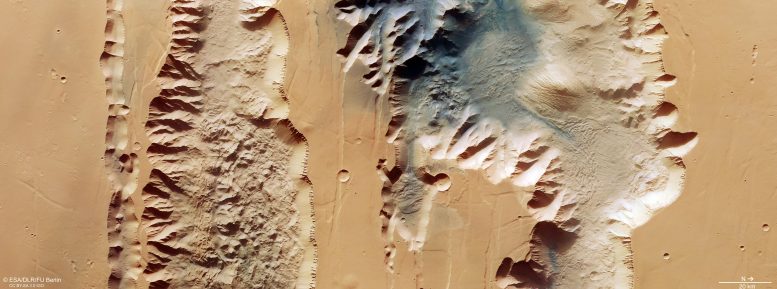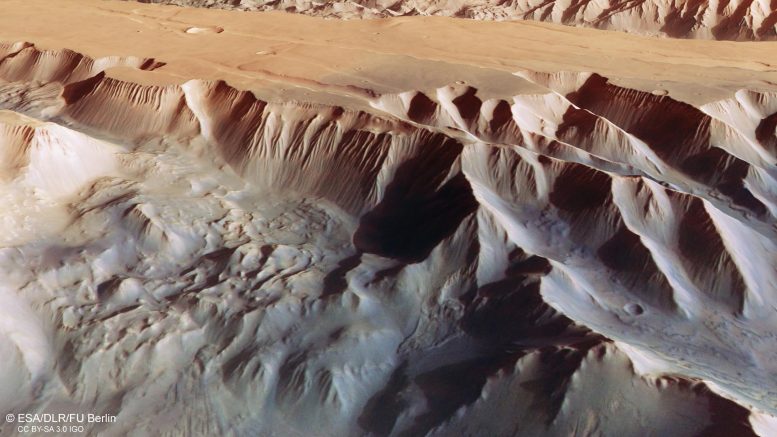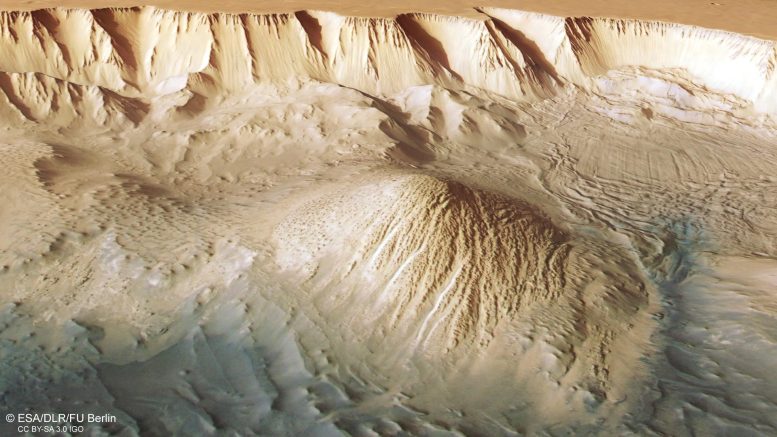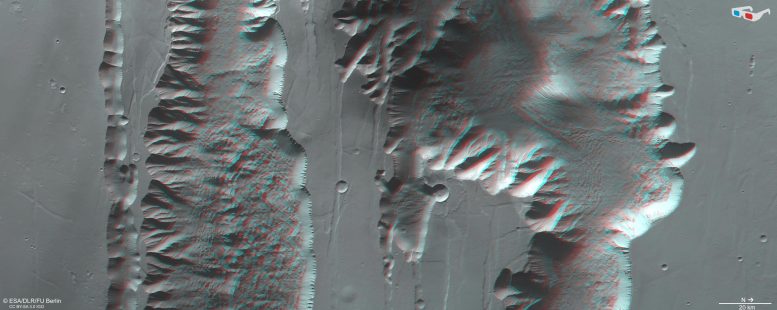
ESA’s Mars Express’s latest image release takes us over two ruptures in the Martian crust that form part of the mighty Valles Marineris canyon system.
Valles Marineris cuts across Mars similar to how the Grand Canyon cuts across the United States, except the latter is tiny in comparison. At 4000 km (2500 miles) long, 200 km (125 miles) wide, and up to 7 km (4 miles) deep, Valles Marineris is spectacular. It is almost ten times longer, 20 times wider, and five times deeper than the Grand Canyon. As the largest canyon system in our Solar System, it would span the distance from the northern tip of Norway to the southern tip of Sicily.

There’s another significant difference between the two: while the Grand Canyon was created as a result of rock being worn away by the Colorado River, Valles Marineris is thought to have formed through the drifting apart of tectonic plates.
The image at the top of this article shows two trenches (or chasma) that form part of western Valles Marineris. On the left (south), is the 840 km-long (522 mile-long) Ius Chasma, and on the right (north) is the 805 km-long (500 mile-long) Tithonium Chasma. Whilst these high-resolution images show incredible surface detail, it is only when we look at an elevation map that we realize how incredibly deep the chasmata are – up to 7 km (4 miles)! At 4809 meters (15,777 feet), the Alps’ tallest mountain Mont Blanc would be dwarfed if it was put inside Tithonium Chasma.

At the top of Tithonium Chasma, a patch of dark sand brings color contrast to the image. This sand may have come from the nearby Tharsis volcanic region.
Next to the dark sand dunes are two light-toned mounds (one cut in half by the upper image border). These ‘mounds’ are more like mountains, rising more than 3000 meters (10,000 feet) in height. Their surfaces have been strongly eroded by Mars’ strong winds, indicating that they are made of a weaker material than the surrounding rock.

Between the two mounds we see a series of smaller bumps, as shown in the second perspective view. Investigations by Mars Express have found water-bearing sulfate minerals in this region. This suggests that these bumps may have formed when liquid that once filled the chasma evaporated, although this theory is still hotly debated.

To the lower right of the mound that we see fully (upper right in the second perspective view), we can see parallel lines and debris piles that indicate a recent landslide. This is also visible as a large purple area in the topography image below. The landslide was caused by the collapse of the canyon wall on the right, and is likely to have occurred relatively recently because it has not been strongly eroded.
The gnarly floor of Ius Chasma is equally fascinating. As tectonic plates pulled apart, they appear to have caused jagged triangles of rock to form that look like a row of shark teeth. Over time, these rock formations have collapsed and eroded.

Exploring Mars
Mars Express has been orbiting the Red Planet since 2003, imaging Mars’ surface, mapping its minerals, identifying the composition and circulation of its tenuous atmosphere, probing beneath its crust, and exploring how various phenomena interact in the martian environment.
The mission’s High Resolution Stereo Camera (HRSC), responsible for these new images, has revealed much about Mars’ diverse surface features, with recent images showing everything from brain terrain and wind-sculpted ridges and grooves through monstrous “claw mark” scratches to volcanoes, tectonic faults, river channels, and ancient lava pools.
Never miss a breakthrough: Join the SciTechDaily newsletter.
9 Comments
“Massive” is a poor choice of words to describe a large canyon, which is a hole in dense, surrounding mass.
Just like “decimate” is mis-used to describe “massive” destruction. It’s lazy mis-use of language.
Decimate should only be used when killing every 10th man in your cohort. Sheesh!
My dog dug a massive hole in my backyard…
Please stop using the word “whilst.” Is this the middle ages? Are we in the court of King whoever the whoever? No. It sounds pretentious
Eat a dick you whiney bored tradgedies at least the author has passion and drive still, at least we have something more relevant than the Kardashian fat asses to look at. No wonder people are depressed its Krabs like you that really take the life out of living hey. Apologise for insulting the poor kid who gives up his free time to probably write this for crumbs because the deserved acclaimed skilled and highly appraised champion wanker such as yourself couldn’t afford the time for such menial task as entertaining or educating the public I mean who would dream of bothering thee such accomplished to educate and invigorate or inspire… Teach that in college did they… Now tell the author something of benefit I want to end this immature unnecessary attack on a positive note. Don’t read it just to find issues with words you would prefer, you weren’t asked to write this so whoever wrote it would have done so using every bit of info available to him so if that’s where he’s at that’s where he’s at… We all start somewhere don’t we. I’m serious apologise and tell the author what you liked I am over the nasty stuff I really am.
Completely agree.
Besides that it’s crazy they complain about a choice of words, they can’t even bring suggestions to make it more to their liking(we can tell you what we think is wrong, but we cant tell you how to make it right). Pretty pathetic lol. It makes me kinda sad that this has to be my constructive comment. To the author, thanks for the great read.
Thank you for your reply to the “Nannybot”. I think the word whilst, despite its long history, gets the writer’s point across just fine. Like others I have enjoyed these fine shots and explanations. GH
Gigantic is better.